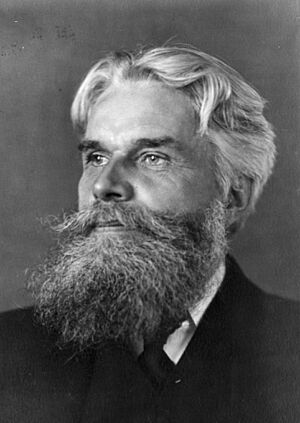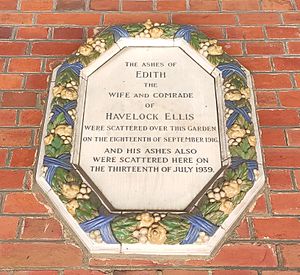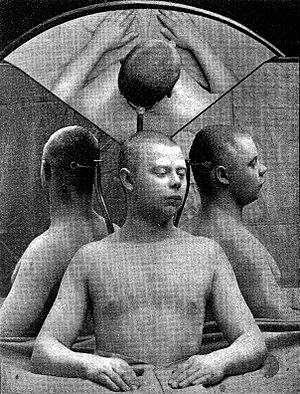Havelock Ellis facts for kids
Quick facts for kids
Havelock Ellis
|
|
|---|---|

Ellis in 1913
|
|
| Born |
Henry Havelock Ellis
2 February 1859 |
| Died | 8 July 1939 (aged 80) Hintlesham, Suffolk, England
|
| Nationality | English, French |
| Alma mater | King's College London |
| Occupation |
|
| Years active | 1879−1931 |
| Spouse(s) | |
Henry Havelock Ellis (born February 2, 1859 – died July 8, 1939) was an English writer and social reformer. He was also a physician, but he focused more on writing and studying society.
Contents
Early Life and Travels
Havelock Ellis was born in Croydon, Surrey, England. His father was a sea captain. His mother's family also had many people who worked on the sea. Havelock had four sisters, and none of them ever married.
When he was seven, Ellis went on a sea voyage with his father. They visited places like Sydney, Australia; Callao, Peru; and Antwerp, Belgium. After this trip, he went to schools near Wimbledon and Mitcham in England.
In April 1875, Ellis sailed to Australia again on his father's ship. He found a job as a teacher at a private school in Sydney. However, he soon lost this job because he didn't have formal training. He then worked as a tutor for a family near Carcoar, New South Wales.
After a year, he became a teacher at a grammar school in Grafton, New South Wales. He took charge of the school for a year after the headmaster passed away. Later, he managed two government elementary schools near Scone, New South Wales. He lived at one of these schools for a year.
Ellis later wrote that his time in Australia was very important. He said it helped him become healthier and find peace. He also realized his life's purpose and decided to become a writer.
Education and Social Work
Ellis returned to England in April 1879. He studied medicine at St Thomas's Hospital Medical School, which is now part of King's College London. Even though he trained as a doctor, he never had a regular medical practice. He earned money by editing old plays.
In 1883, he joined a group called The Fellowship of the New Life. This group included other people who wanted to improve society. He met famous social reformers like Eleanor Marx and George Bernard Shaw through this group.
Marriage and Later Life
In November 1891, when he was 32, Ellis married Edith Lees. She was an English writer and supported women's rights. After their honeymoon, Ellis went back to his own home. Edith lived in a house connected to the Fellowship group.
Havelock Ellis spent his final year in Hintlesham, Suffolk. He passed away in July 1939. His ashes were scattered at Golders Green Crematorium in North London.
Selected Works
Ellis wrote many books and essays during his life. His writings explored different ideas about society and human behavior.
- The Criminal (1890)
- The New Spirit (1890)
- The Nationalisation of Health (1892)
- Affirmations (1898)
- The Nineteenth Century (1900)
- A Study of British Genius (1904)
- The Soul of Spain (1908)
- The World of Dreams (1911)
- The Task of Social Hygiene (1912)
- The Philosophy of Conflict (1919)
- Little Essays of Love and Virtue (1922)
- Sonnets, with Folk Songs from the Spanish (1925)
- The Art of Life (1929)
- More Essays of Love and Virtue (1931)
- My Confessional (1934)
- Questions of Our Day (1934)
- From Rousseau to Proust (1935)
- Selected Essays (1936)
- Poems (1937)
- Love and Marriage (1938)
Translations by Ellis
Havelock Ellis also translated books from other languages into English.
- Germinal (by Zola) (1895)
- The Psychology of the Emotions by Théodule-Armand Ribot (1897)




